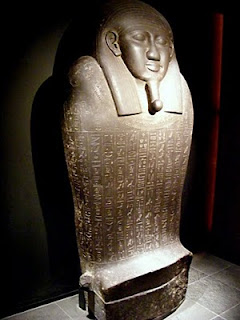
Copyright Rick Menges, with my thanks
Lid of the sarcophagus of General Kheperre
Late Period, Dynasty 26, reign of Amasis, 570–526 B.C.
Giza
Greywacke
Museum of Fine Arts, Boston
Late Period, Dynasty 26, reign of Amasis, 570–526 B.C.
Giza
Greywacke
Museum of Fine Arts, Boston
Thanks to Rick Menges for rescuing me from the photographic void by supplying me with a serious set of photos from his museum visits in the US. The first set is from the Museum of Fine Arts in Boston. I don't have captions for all the photographs but the MFA website has a database which has provided information for some of them.
Here's what the MFA has to say about this wonderful stone sarcophagus:
Lid of the sarcophagus of General Kheperre
Egyptian
Late Period, Dynasty 26, reign of Amasis
570–526 B.C.
Greywacke
Overall: 76 x 108 x 226cm (29 15/16 x 42 1/2 x 89in.)
Framed (Vertical square steel tubes(H-shaped-3-horiz-connecters/bot plat): 208.3 x 90.2 x 7.6 cm (82 x 35 1/2 x 3 in.)
Framed (Vertical steel tube welded to bottom steel plate anchor to floor): 0.6 x 61 x 48.3 cm (1/4 x 24 x 19 in.)
Museum of Fine Arts, Boston
Harvard University—Boston Museum of Fine Arts Expedition
30.834b
Although best known for its Old Kingdom monuments, the site of Giza experienced a revival during Dynasty 26. The small temple dedicated to Isis, "Lady of the Pyramids," that had grown up in one of the queens' pyramid chapels in the cemetery east of the Great Pyramid, was expanded; the pyramid of Menkaura was restored and the royal mummy provided a new wooden coffin; and the Old Kingdom necropolis once again became a burial place of choice for people of means. One of these was Kheperre, an army general, who chose to be buried in the cemetery east of the Great Pyramid, not far from the Temple of Isis. In Khufu's day this cemetery had been reserved for members of the royal family, and the whole area was crowded with Old Kingdom tombs. Although many Twenty-sixth Dynasty officials chose to convert old burial shafts for their tombs, Kheperre opted to dig a completely new tomb for himself and his family consisting of a deep shaft sunk fifty feet into the bedrock with ten small burial chambers opening from it at various levels. Kheperre's chamber, being the most important, was at the deepest level.
Although the entrance was originally plugged with stone blocks cemented in place, robbers succeeded in entering the tomb. By the time modern excavators found it, there was only Kheperre's mammoth sarcophagus containing the paltry remains of his body, and 109 shawabtys, or funerary figures, of lustrous blue-green faience. Huge, hard stone sarcophagi of anthropoid shape, not used since the New Kingdom were once again in vogue during Dynasty 26. Kheperre's is a fine example of the later form. It is very wide in relation to its height, and the head is disproportionately large. The deceased is represented in the form of a mummy standing on a pedestal with a round flat face, large eyes, a broad nose, and full lips. The wig and beard associate the deceased with the god Osiris.
Provenance/Ownership History: From Egypt, Giza: G 7757 A, (tomb of Kheperre) Room X. November, 1929: excavated by the Harvard University-Museum of Fine Arts Expedition; 1930: assigned to the MFA by the government of Egypt.


1 comment:
I've actually seen this one! Lovely. Thanks
Post a Comment